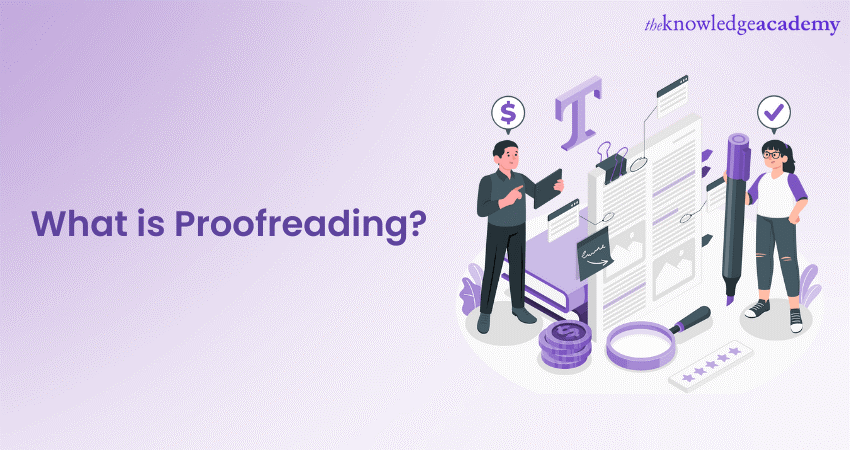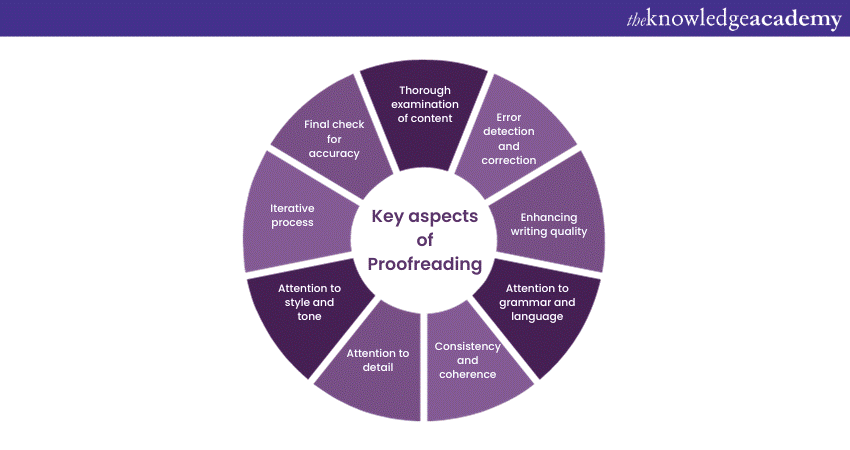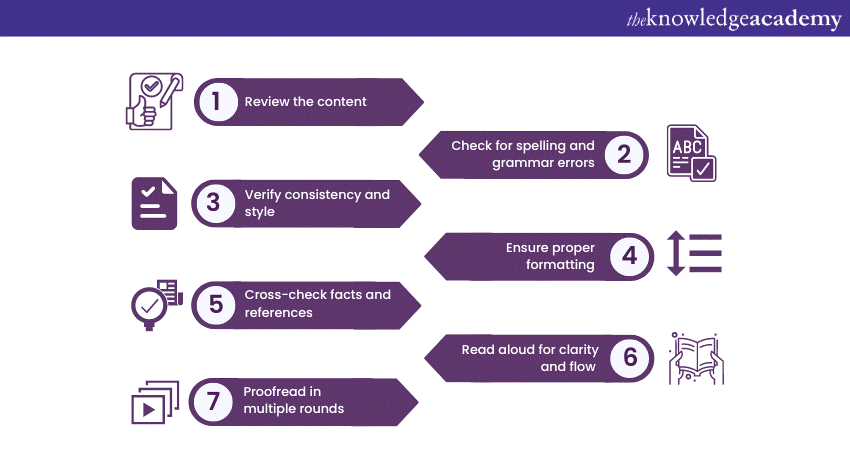We may not have the course you’re looking for. If you enquire or give us a call on 01344203999 and speak to our training experts, we may still be able to help with your training requirements.
Training Outcomes Within Your Budget!
We ensure quality, budget-alignment, and timely delivery by our expert instructors.

Writing is a powerful form of communication, and when it comes to producing high-quality content, Proofreading plays a crucial role. Proofreading is the process of carefully reviewing and correcting written materials to ensure accuracy, clarity, and professionalism. In this blog, we will guide you through What is Proofreading, the process of Proofreading and highlight its significance in various contexts.
Table of Contents
1) Understanding “What is Proofreading?” and its aspects
2) Importance of Proofreading
3) Benefits of Proofreading
4) Step-by-step guide to Proofreading
a) Review the content
b) Check for spelling and grammar errors
c) Verify consistency and style
d) Ensure proper formatting
e) Cross-check facts and references
f) Read aloud for clarity and flow
g) Proofread in multiple rounds
5) Conclusion
Understanding “What is Proofreading?” and its aspects
Before we move on to the step-by-step guide, we will first define Proofreading. Proofreading is the meticulous process of reviewing written content to identify and correct errors in grammar, spelling, punctuation, formatting, and overall clarity. Understanding Proofreading is essential for anyone involved in the writing process. Let's explore the key aspects of understanding Proofreading in more detail:

1) Thorough examination of content: Proofreading goes beyond a cursory read-through of a document. It involves a meticulous examination of the content to identify and rectify errors. This examination encompasses grammar, punctuation, spelling, formatting, consistency, style, and overall coherence.
2) Error detection and correction: The primary goal of Proofreading is to identify and correct errors in written materials. These errors can range from simple typos and grammatical mistakes to more complex issues like inconsistent formatting or unclear sentence structure. Proofreading ensures that these errors are identified and fixed, resulting in polished and error-free content.
3) Enhancing writing quality: Proofreading is an integral part of the writing process that contributes to improving the overall quality of the written work. By eliminating errors, Proofreading enhances the clarity, readability, and coherence of the content. It ensures that the message is effectively conveyed to the intended audience.
4) Attention to grammar and language: Proofreading involves paying close attention to grammar and language usage. It includes checking for proper subject-verb agreement, verb tenses, correct word choice, and sentence structure. Through Proofreading, inconsistencies and errors in grammar and language are identified and rectified, ensuring that the writing adheres to the rules and conventions of the English language.
5) Consistency and coherence: Proofreading also focuses on maintaining consistency and coherence throughout the document. This includes checking for consistent use of terminology, formatting, headings, and citation styles. By ensuring consistency, Proofreading helps to create a cohesive and unified piece of writing that is easier for readers to follow and understand.
6) Attention to detail: Proofreading requires a keen eye for detail. It involves scrutinising every aspect of the writing, including punctuation, spacing, indentation, and formatting. By paying attention to these details, Proofreading helps to eliminate errors and inconsistencies that might otherwise be overlooked.
7) Attention to style and tone: Proofreading considers the style and tone of the writing. It ensures that the content aligns with the desired style guide or guidelines. This includes checking for appropriate language usage, tone consistency, and adherence to specific writing conventions. Proofreading ensures that the writing maintains the intended style and tone, enhancing the overall effectiveness of the message.
8) Iterative process: Proofreading is an iterative process that involves multiple rounds of review. Each round focuses on different aspects, such as grammar, spelling, formatting, consistency, or style. Through these rounds, errors are gradually eliminated, and the content is refined for optimal quality.
9) Final check for accuracy: Proofreading serves as the final check for accuracy before the content is published or shared. It verifies the factual accuracy of information, confirms proper citations and references, and ensures the overall integrity of the content. By conducting this final accuracy check, Proofreading helps to maintain the credibility and reliability of the written work.
Elevate your Proofreading skills with our Proofreading Masterclass and unlock the power of error-free written communication!
Importance of Proofreading
Now that we know the definition of Proofreading and its aspects, let's delve into the key reasons Why Proofreading is Important:
1) Maintaining credibility: Proofreading ensures that your written work is free from errors, showcasing your professionalism and attention to detail. By presenting polished and accurate content, you establish credibility and trust with your readers. Whether it's an academic paper, business document, or blog post, Proofreading demonstrates your commitment to delivering high-quality work.
2) Enhancing clarity and understanding: Clear and error-free writing is essential for effective communication. Proofreading helps eliminate grammar, spelling, and punctuation mistakes that can hinder comprehension. By ensuring your writing is clear and coherent, you help readers understand your ideas and messages accurately, avoiding any confusion or misinterpretation.
3) Polishing the presentation: Proper Proofreading ensures that your writing adheres to the desired formatting, style, and tone. Consistency in formatting, headings, font usage, and indentation contributes to a professional and polished appearance. When your work is well-presented and consistent, it reflects positively on your writing skills and attention to detail.
4) Quality assurance: Proofreading is a quality assurance step that helps you deliver the best possible work. It enables you to identify and rectify any weak points, inconsistencies, or areas for improvement in your writing. By striving for excellence through Proofreading, you demonstrate your commitment to producing high-quality content.
5) Professional growth: Engaging in the Proofreading process consistently can enhance your writing skills and attention to detail. It trains you to identify and correct errors, refine your style, and develop a stronger command of language. Over time, regular Proofreading helps you become a more proficient writer and communicator.
Benefits of Proofreading
Proofreading is considered to be an essential step in the writing process that offers numerous benefits. Let's explore the key benefits of Proofreading in more detail:
1) Enhanced credibility and professionalism: Proofreading ensures that your written content is free from errors, making it more credible and professional. When your work is polished and error-free, it demonstrates your attention to detail and dedication to producing high-quality materials. This, in turn, enhances your credibility and reputation as a writer or organisation.
2) Improved clarity and comprehension: Proofreading helps to clarify your ideas and improve the overall coherence of your writing. By eliminating errors, awkward phrasing, and unclear sentences, you make your content easier to understand for your audience. Clear and well-structured writing enhances comprehension, allowing your readers to grasp your message more effectively.
3) Minimised misinterpretation and confusion: Error-free writing reduces the risk of misinterpretation or confusion among your readers. When your content is clear and accurate, it ensures that your message is conveyed precisely as intended. This helps to avoid any misunderstandings and ensures that your readers correctly grasp the information or ideas you are trying to communicate.
4) Increased professionalism in communication: Whether you are writing an academic paper, a business report, or a blog post, Proofreading adds a professional touch to your communication. It shows that you take your work seriously and have a high standard of quality. Professionally proofread content reflects positively on your image and fosters trust and respect from your readers.
5) Improved readability and engagement: Proofreading enhances the readability of your content, making it more engaging for your audience. By eliminating errors, awkward sentences, and confusing phrases, you create a smooth and enjoyable reading experience. When your writing flows well and is free from distractions, readers are more likely to stay engaged and continue reading.
6) Maintained brand consistency: For businesses and organisations, Proofreading helps to maintain brand consistency across written materials. By adhering to consistent language, style, and tone, you reinforce your brand's identity and messaging. Consistent and error-free writing contributes to a cohesive and professional brand image.
7) Error-free facts and references: Proofreading ensures the accuracy of facts, data, quotes, and references in your content. Cross-checking and verifying information during the Proofreading process helps you to avoid spreading misinformation or using unreliable sources. Accurate and properly cited information strengthens the credibility of your work and builds trust with your readers.
8) Reduced embarrassment and reputational damage: Proofreading is a proactive measure to prevent embarrassing mistakes or errors that can damage your reputation. Typos, grammatical errors, or factual inaccuracies can undermine your professionalism and credibility. By thoroughly Proofreading your content, you minimise the risk of publishing content with avoidable mistakes.
9) Better writing habits and skills: Regularly engaging in the Proofreading process helps you develop better writing habits and skills. By paying attention to the details and identifying errors, you become more conscious of your writing style, grammar rules, and formatting conventions. Over time, this improves your overall writing proficiency and enables you to produce higher-quality content.
Master the art of Attention Management and reclaim control of your time with our transformative Attention Management Training!
Step-by-step guide to Proofreading
This section of the blog will present you with a step-by-step guide to Proofreading:

Review the content
To begin the Proofreading process, start by reviewing the entire content. This step allows you to gain a comprehensive understanding of the material, its purpose, and the target audience. While reviewing, take note of any areas that require attention or improvements.
Check for spelling and grammar errors
Next, thoroughly check the content for spelling and grammar errors. Look out for common mistakes such as typos, misspelt words, incorrect verb forms, subject-verb agreement issues, and punctuation errors. Utilise spelling and grammar check tools, but you must remember that they are not foolproof and should be used alongside manual review.
Verify consistency and style
Consistency in writing is vital for maintaining a smooth flow and ensuring the readers' comprehension. Verify that the terminology, formatting, headings, and citation styles are consistent throughout the document. Also, adhere to the specified style guide or guidelines, such as the Oxford Style Manual or The Guardian Style Guide, to maintain a unified and professional appearance.
Ensure proper formatting
Formatting plays a significant role in the overall presentation of the document. Pay attention to the font styles, sizes, line spacing, margins, and indentation. Ensure that the formatting is consistent throughout and adheres to the desired standards or guidelines. Well-formatted content enhances readability and gives a polished look to the document.
Cross-check facts and references
For content that relies on facts, data, or references, it is essential to cross-check their accuracy and reliability. Verify the information, statistics, quotes, and references against credible sources. Ensure that all facts are properly cited and attributed. This step helps maintain the credibility of the content and avoids spreading misinformation.
Read aloud for clarity and flow
Reading the content aloud is a valuable technique to assess its clarity, flow, and overall effectiveness. Pay attention to sentence structure, coherence between paragraphs, and the overall tone of the writing. Reading aloud helps identify awkward phrasing, unclear sentences, and areas that may require rephrasing or restructuring to enhance the reader's understanding and engagement.
Proofread in multiple rounds
To ensure thorough Proofreading, it is recommended to go through multiple rounds of review. Each round can focus on specific aspects such as grammar, spelling, consistency, formatting, and style. Taking breaks between rounds allows you to approach the content with a fresh perspective, making it easier to spot any overlooked errors or areas for improvement.
During each round, carefully review the content, making necessary corrections and adjustments. Pay attention to the changes made in previous rounds to ensure consistency and accuracy throughout the document. This iterative process helps refine the content and ensure its quality.
Conclusion
Proofreading is a critical process in the journey of producing impeccable written content. By following the step-by-step guide outlined in this blog, you can improve the accuracy, clarity, and professionalism of your writing. Remember to dedicate ample time and attention to each stage of the Proofreading process to ensure optimal results. Hope this blog answered all your questions on What is Proofreading!
Ignite your personal development journey with our comprehensive Personal Development Training and unlock your true potential today!
Frequently Asked Questions
Upcoming Business Skills Resources Batches & Dates
Date
 Report Writing Course
Report Writing Course
Fri 7th Jun 2024
Fri 16th Aug 2024
Fri 4th Oct 2024
Fri 6th Dec 2024







 Top Rated Course
Top Rated Course



 If you wish to make any changes to your course, please
If you wish to make any changes to your course, please


